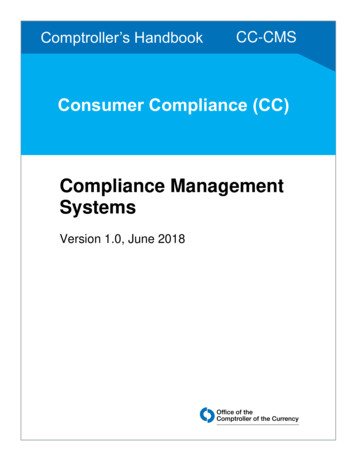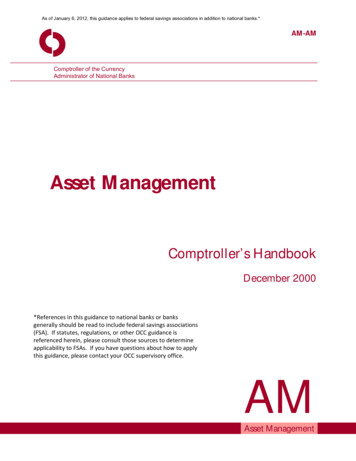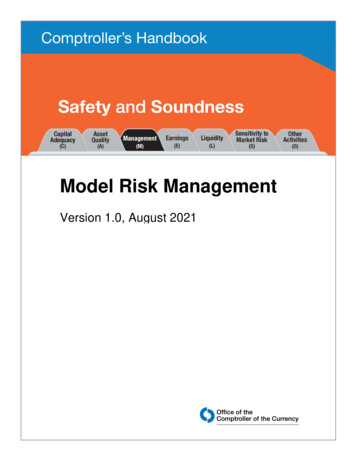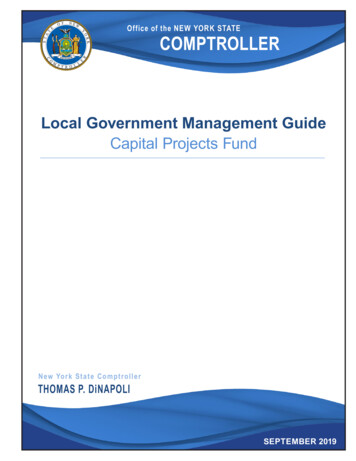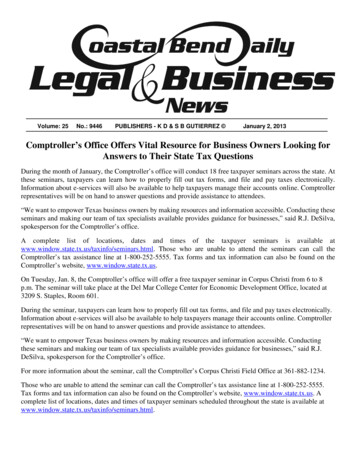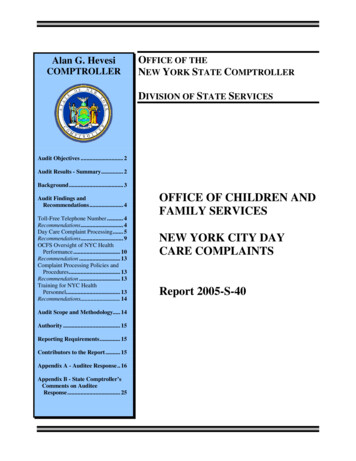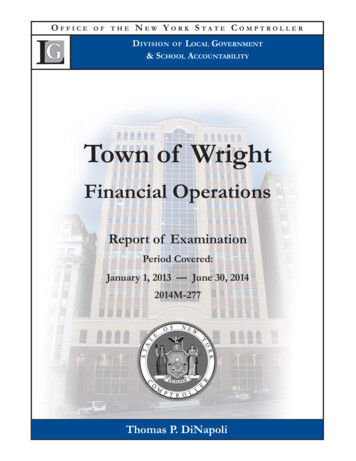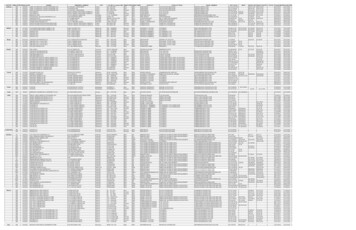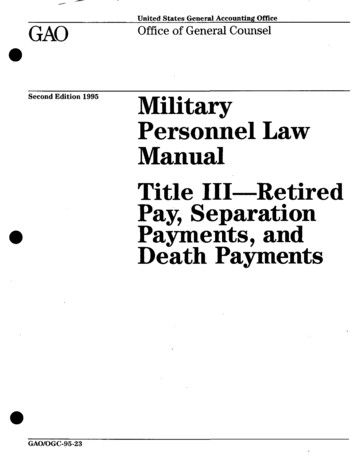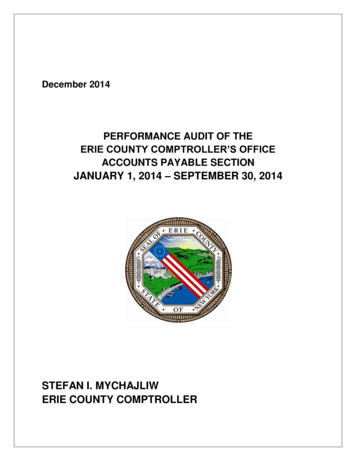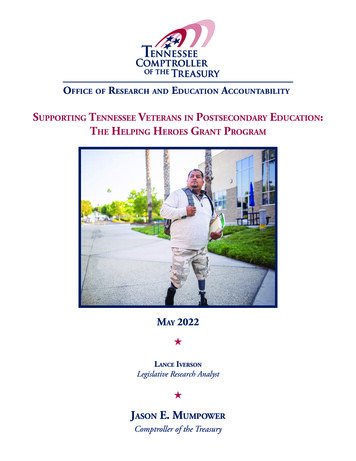
Transcription
Office of Research and Education AccountabilitySupporting Tennessee Veterans in Postsecondary Education:The Helping Heroes Grant ProgramMay 2022Lance IversonLegislative Research AnalystJason E. MumpowerComptroller of the Treasury
IntroductionIn 2008, the General Assembly passed Public Chapter 1142, creating the Helping Heroes Grant program toprovide higher education-related financial assistance to Tennessee citizens who are decorated, post 9/11 veterans.The grants, established in Tennessee Code Annotated 49-4-938 as part of the state’s system of lottery-fundedscholarships, are intended to offset the costs of postsecondary education for qualifying veterans.Helping Heroes Grants are either 500 per semester forpart-time students (enrollment in 6 to 11 semester hours)or 1,000 per semester for full-time students (enrollmentin 12 or more semester hours). Qualifying veterans may usethe grants as supplements to other sources of postsecondaryfinancial aid. The Tennessee Student Assistance Corporation(TSAC) administers the Helping Heroes Grant program.PC 1142 requires the Comptroller’s Office to review andstudy the effectiveness of these grants in educating veterans,beginning in the fifth year of the grant’s inception (academicyear 2012-13) and every four years thereafter.This brief represents the Comptroller’s third review ofHelping Heroes Grants.Tennessee’s lottery-funded grant systemThe Tennessee Education Lottery, whichbegan in January 2004, funds severalpostsecondary scholarships and grants foreligible Tennessee students. Originally, theTennessee Education Lottery ScholarshipProgram consisted of three programs:HOPE (including the General AssemblyMerit Scholarship and ASPIRE), the Accessaward, and the Wilder-Naifeh TechnicalSkills Grant. In subsequent years, theGeneral Assembly has passed legislationauthorizing the Tennessee Education Lotteryto finance several additional programs. TheHelping Heroes Grant program is one ofthose programs, authorized in 2008.MethodologyThis report focuses on the last four years of Helping Heroes Grant program operation (since the 2017-18academic year) using data provided by the Tennessee Higher Education Commission (THEC) on the: demographic characteristics of Helping Heroes Grant recipients; number of credits accumulated by Helping Heroes Grant recipients; and Helping Heroes Grant payments received by participating institutions of higher education in Tennessee.Qualifications for the Helping Heroes GrantTo qualify for a Helping Heroes Grant, a veteran must: be a Tennessee citizen and resident of Tennessee for one year immediately preceding the dateof application; apply or reapply for a Helping Heroes Grant for any semester in which the student enrolls for 6 or moresemester hours; be admitted to, and enroll in, an eligible postsecondary institution, seeking a certificate or an associateor bachelor’s degree; be a former member of the armed forces who has received an honorable discharge, or a former or currentmember of a reserve or a Tennessee National Guard unit who was called into active military service; have been awarded: the Iraq Campaign Medal; the Afghanistan Campaign Medal; the Global War on Terrorism Expeditionary Medal, on or after September 11, 2001; or a service expeditionary medal to be specified by rule as the Inherent Resolve Campaign Medal;2
be in compliance with federal drug-free rules and laws for receiving financial assistance; not be in default on a federal Title IV educational loan or Tennessee educational loan; not owe a refund on a federal Title IV student financial aid program or a Tennessee student financialaid program; not be incarcerated; and have not yet received a bachelor’s degree.Grant recipients are not required to meet any academic standard at the time of their enrollment to qualify forthe grant. Grant recipients may continue to receive the grant as long as they meet the qualifications until oneof the following occurs: the student earns a bachelor’s degree; the student receives the grant for the equivalent of eight full semesters (with part-time studentsaccumulating half-semesters); or the student is no longer maintaining “satisfactory academic progress” as determined by theinstitution attended.TSAC rules provide grant recipients a means to appeal a postsecondary institution’s decision to deny or revokea Helping Heroes Grant. Institutions must maintain procedures and review panels and notify applicantsand grant awardees about the process and time frame required to appeal. To date, no Helping Heroes Grantawardees or recipients have made any appeals.Recent changes to the Helping Heroes Grant programIn 2020, Public Chapter 794 created the Financial Aid Simplification for Tennesseans (FAST) Act. Prior tothe FAST Act, Helping Heroes Grant recipients were required to pay for a semester of school in advance andthen successfully complete at least 6 credit hours before being reimbursed through Helping Heroes funds.Under the FAST Act, recipients receive the Helping Heroes Grant upon enrollment in at least 6 credit hoursin a participating college or university.The FAST Act also applied the “satisfactory academic progress” requirement to students receiving HelpingHeroes Grants to maintain their grant eligibility. Satisfactory academic progress is a set of criteria used todetermine whether a student can continue to receive financial aid. The U.S. Department of Education hasguidelines for defining “satisfactory academic progress” but allows each institution to fully specify the criteria.Generally, standards for satisfactory academic progress include: a GPA minimum (e.g., recipients must maintain a 2.0 GPA); a course passage requirement for each semester (e.g., at least two-thirds of courses must be passed); and a maximum number of credits a student can attempt (e.g., a student can remain eligible only for the first180 credits attempted toward a bachelor’s degree, which typically requires 120 credits).In 2021, Public Chapter 368 expanded eligibility for the Helping Heroes Grant to include veterans who havebeen awarded a service expeditionary medal. A new TSAC rule will go before the Government Operations RuleReview committee in 2022 to formally identify and recognize this service expeditionary medal as the InherentResolve Campaign Medal. PC 368 also removed the statutory cap of 750,000 in total Helping Heroes Grantexpenditures per year. The 2021 General Appropriations Act (PC 454) allocated 30,300 in the first year and 53,400 in all future years starting in fiscal year 2022-23 to fund this expansion of grant eligibility.3
Grant amounts and usesThe Helping Heroes Grant is funded through the state’s lottery scholarship program and is administered byTSAC. Public Chapter 1142 (2008) originally set a cap of 375 recipients per semester and 750,000 in totalgrant expenditures per year. The General Assembly removed the cap on the number of recipients in 2009, andthe cap on total annual expenditures was removed in 2021.TSAC awards Helping Heroes Grants to qualified veterans. Grant awards are either 500 per semester forpart-time students (enrollment in 6 to 11 semester hours) or 1,000 per semester for full-time students(enrollment in 12 or more semester hours). A student must continue to meet the Helping Heroes Grantrequirements and reapply to TSAC each academic year to retain the grant. Grant recipients can use thefunding to pay for tuition, fees, books, on-campus housing, and any expense that is considered part of thetotal cost of attending the higher education institution. Helping Heroes Grants can be used for remedial anddevelopmental courses as well as distance education courses.A student’s Helping Heroes Grant will be reduced by the receipt of other financial aid sources only if thestudent’s total aid exceeds the total cost of attendance at an eligible postsecondary institution. For example, ifa student’s total cost of attendance during a semester was 4,568 and the student received 4,600 in financialaid, of which 1,000 was a Helping Heroes Grant, the 32 difference would be deducted from the HelpingHeroes Grant.Most Helping Heroes Grant recipients attend locally governed institutions, which received 1.23 million ingrant funds between 2017 and 2021. Community colleges received 393,024 during the same period, and theUniversity of Tennessee System received 213,000.AExhibit 1: Most Helping Heroes funding was received by locally governedinstitutionsFY 2017-18 through FY 2020-21College/university systemFunds receivedLocally governed institutions 1,230,000TBR community colleges 393,024University of Tennessee System 213,000Independent colleges and universities 185,500Proprietary institutions 21,000Total 2,042,524Source: Tennessee Higher Education Commission.Austin Peay State University enrolled the most Helping Heroes Grant recipients between 2017 and 2021,receiving 591,500 in grant funds. Middle Tennessee State University received the second highest amountof Helping Heroes Grant funds at 409,500, followed by the University of Tennessee – Knoxville with 160,000. Pellissippi State Community College received 111,000 for its Helping Heroes students, the mostof any community college.ASee Appendix B for a list of Helping Heroes Grant awards by institution.4
Exhibit 2: Approximately half of Helping Heroes funding was used at AustinPeay State University and Middle Tennessee State UniversityTBR Community Colleges 19.2%Middle Tennessee StateUniversity 20.0%Austin Peay State University s3.8%ETSU1.8%TSU1.4%Locally Governed InstitutionsProprietaryUniversity of TennesseeTBR Community CollegesUniversity ofTennessee 10.4%Independent Colleges& Universities 9.1%Proprietary 1.0%Independent Colleges andUniversitiesNotes: (1) Percentages displayed for individual locally governed institutions represent their percentage shares of total Helping Heroes Grants expenditures.(2) TBR refers to Tennessee Board of Regents; ETSU, East Tennessee State University; and TSU, Tennessee State University.Source: Tennessee Higher Education Commission.Demographics of Helping Heroes Grant recipientsThe demographic makeup of Helping Heroes Grant recipientstracks with broader state and military demographics.Each academic year from 2017 to 2021, the Helping Heroes Grant program awarded between 83 and 89percent of grants to men and between 11 and 17 percent to women. In 2020, the gender balance of the totalDepartment of Defense military force of 2,129,777 people was 18.7 percent female and 81.3 percent male.In 2020-21, almost three-quarters of Helping Heroes Grant recipients (72 percent) were White. Fifteenpercent of recipients were African American and 8 percent were Hispanic. This distribution almost exactlymatches the racial demographics of Tennessee.ConclusionThe number of Helping Heroes Grant recipients completingbachelor’s degrees, associate degrees, and certificates hasdecreased since 2017 correlating with a general decrease inprogram participation.From academic years 2013-14 through 2019-20, Helping Heroes Grant recipients consistently completed over190 associate degrees, bachelor’s degrees, and certificates annually. In academic years 2016-17 and 2017-18,the number of such awards completed was 223 and 222, respectively. In 2020-21, however, the number ofawards had dropped to 143, a reduction of almost 36 percent from four years earlier.BCompletion rates declined slightly at two-year institutions and held steady at four-year institutions between 2017 and 2021. The rate of completion for recipientswho attended a two-year institution declined from 50.2 percent to 44.6 percent. For those who attended a four-year institution, the rate of completion held steady ataround 83 percent over the time period.B5
Exhibit 3: Among Helping Heroes Grant recipients, the number of bachelor’sdegrees, associate degrees, and certificates decreased by more than a thirdfrom 2017-18 to 2020-21Number of degrees and 2020-21Academic yearsSource: Tennessee Higher Education Commission.The decrease in awards is attributable to a general decrease in participation in the program since 2017. Sincethe 2018-19 academic year, the number of recipients has declined annually.Exhibit 4: Since the 2018-19 academic year, the number of Helping Heroes- Grant recipients has declined annually600Number of grant c years2016-172018-192020-21Note: The total number of unique grant recipients since the inception of the Helping Heroes program is 5,408.Source: Tennessee Student Assistance Corporation Board Report.There were 499 grant recipients in academic year 2016-17 compared to 196 for 2020-21, a decrease of almost61 percent over four years.Reasons for the decrease include a reduction in qualified recipients (i.e., fewer individuals meet the militaryrequirements) and the effects of the COVID-19 pandemic over the past two academic years (e.g., potentialstudents may have not enrolled due to health concerns or work responsibilities).6
Between academic years 2011-12 and 2016-17, Helping Heroes Grants averaged 761,748 in annualexpenditures and served an average of 492 students per year. The amount of annual expenditures was ingeneral alignment with the budget for these grants. The program had a budget of 780,300 in 2021, of which 30,300 was included in the 2021 Appropriations Act for the expansion to include service expeditionarymedal recipients.C Between 2018 and 2021, however, the average annual expenditures were 508,068, with anaverage of 332 students per year.D450 800,000400 700,000350 600,000300 500,000250 400,000200 300,000150 200,000100 100,000500StudentsExpendituresAnnual expendituresNumber of Helping Heroes studentsExhibit 5: In the Helping Heroes Grant program, the number of participatingstudents and the amount of grant expenditures have both declined since2018-192017-18419 644,5002018-19424 667,0002019-20287 414,522StudentsExpenditures2020-21196 306,250 -Source: Tennessee Student Assistance Corporation Board Report.Twenty years removed from 9/11 and over a decade since peak levels of members of the armed services in thecombat theaters of the Middle East, there are fewer qualifying veterans in the pool for potential grants. With fewerservice members engaged in qualifying military activities, the number of Helping Heroes Grants has decreased.See page 3 for more information on the 2021 Helping Heroes program expansion.Between 2014 and 2017, the amount of Helping Heroes Grants awarded to veterans was 2,998,904. However, over an equal number of years (FY 2018 – FY2021), the total amount of Helping Heroes expenditures was 2,032,272, a reduction of 32 percent compared to the prior four-year period. This reduction is in linewith the decrease in students served over the period.CD7
Exhibit 6: Reduction of U.S. Armed Forces in Afghanistan, Iraq, and Syria 2007-2017US armed services personnel l fiscal year2014201520162017Notes: The federal fiscal year is October 1 through September 30. Data for U.S. Armed Forces not available after FY 2017.Source: Congressional Research Service, February 22, 2021.In 2021, the program’s qualifications were broadened by the General Assembly to include veterans who havebeen awarded a service expeditionary medal. The General Assembly included 53,400 of recurring money tofinance this expansion.Policy OptionsThe General Assembly may wish to consider increasing grantamounts for Helping Heroes Grant recipients or reducing theannual amount budgeted for the grants.In 2021, 306,250 in Helping Heroes grants were awarded out of a total budget of 803,400.E Grantamounts could be increased slightly or more substantially. For example, assuming the number of recipientsholds steady, the grant could be increased by 2.5 times and remain within the budget. (See Exhibit 7.) Thischange assumes increased grant amounts would not result in a higher participation rate.Exhibit 7: Helping Heroes Grant amounts could be increased and remainwithin the budget for the programCurrent grant value policy 500 for part-time student; 1,000 for full-timePotential grant value policy 1,250 for part-time student; 2,500 for full-timeBudget impactFY 2022-23 budgetBudget impact 803,400 FY 2022-23 budgetEstimated expenditures atcurrent grant amount ( 306,250)Estimated expenditures at 2.5times the current grant amount Estimated unspent funds 497,150 Estimated unspent funds 803,400( 765,625) 37,775Note: Estimated expenditures based on FY 2021.Source: OREA analysis.Although the statutory cap on expenditures was removed by PC 368 (2021), as detailed on page 3 of this report, this report uses 803,400 as the “budget” forthe Helping Heroes program. This amount is calculated based on the 750,000 from PC 1142 (2008) and the 53,400 from PC 368 (2021) that was specificallyappropriated from Tennessee Lottery for Education Account recurring funds to be spent on Helping Heroes Grants.E8
The 2022 General Assembly considered bills increasing other Lottery for Education Account scholarshipvalues, including the HOPE scholarship and Middle College Scholarship. An increase in the Helping HeroesGrant amount would correlate with these broader considerations. If this policy change were adopted, grantvalues would increase as detailed in Exhibit 8.Exhibit 8: Helping Heroes Grants at the current value and raised by 2.5 timesin valuePer semester scholarship descriptionCurrent grantIncreased 2.5 times1/2 grant for a part-time student 500 1,250Full grant for a full-time student 1,000 2,500Source: OREA analysis.Alternatively, the General Assembly could reduce the annual amount budgeted for the grants and authorizethe transfer of funding made available by the reduced Helping Heroes Grants budget to other lottery-fundedprograms or the Tennessee Promise endowment.The General Assembly may wish to consider authorizingHelping Heroes Grants for use at Tennessee Colleges of AppliedTechnology (TCATs).Tennessee law presently does not allow for use of Helping Heroes Grants at TCATs. Allowing this grant to beexpended on education at TCATs could allow for additional use of this grant by qualifying veterans.The General Assembly may wish to encourage greater publicawareness of Helping Heroes Grants.More public outreach may lead to increased use of Helping Heroes Grants by qualifying veterans of thearmed forces.9
Appendix A: Helping Heroes Grant recipients’ top10 majors from 2017-2020 by number and percentof studentsLiberal Arts and Sciences was the most popular major for Helping Heroes Grantrecipients from 2017-2020Cohort year2017 cohort2018 cohort2019 cohort2020 cohortTop 10 majors (including ties)StudentsPercentLiberal Arts & Sciences4821.62%Business Management & Administrative Services2913.06%Engineering2812.61%Health Professions & Related Services177.66%Computer & Information Services156.76%Protective Services & Public Affairs146.31%Biological Sciences/Life Sciences114.95%Social Sciences104.50%Trades & Industrial94.05%Physical Sciences83.60%Liberal Arts & Sciences3316.67%Business Management & Administrative Services3115.66%Engineering2914.65%Health Professions & Related Services147.07%Computer & Information Services126.06%Protective Services & Public Affairs115.56%Parks, Recreation, Leisure, & Fitness Studies115.56%Social Sciences105.05%Agriculture94.55%Trades & Industrial73.54%Liberal Arts & Sciences3920.42%Engineering3116.23%Business Management & Administrative Services2312.04%Health Professions & Related Services2211.52%Protective Services & Public Affairs178.90%Trades & Industrial115.76%Computer & Information Services115.76%Parks, Recreation, Leisure, & Fitness Studies94.71%Social Sciences63.14%Agriculture63.14%Liberal Arts & Sciences4128.67%Engineering1913.29%Business Management & Administrative Services149.79%Health Professions & Related Services128.39%Computer & Information Sciences117.69%Protective Services & Public Affairs85.59%Parks, Recreation, Leisure, & Fitness Studies85.59%Social Sciences53.50%Physical Sciences53.50%Trades & Industrial42.80%Biological Sciences/Life Sciences42.80%Multi/Interdisciplinary Studies42.80%Note: Cohorts are defined as the first term in which the student receives the Helping Heroes Grant (e.g., students who enrolled in summer 2017, fall 2018, andspring 2018 are included in the 2017 cohort). Data reflects majors declared during the first term students received the Helping Heroes Grant.Source: Tennessee Higher Education Commission.10
Appendix B: Helping Heroes Grant awards byinstitution and academic -21StudentsGrant TotalStudentsGrant TotalStudentsGrant TotalStudentsGrant TotalBelmont University21 33,50011 20,0003 3,0003 5,0000Bethel University17 25,5007 10,0005 7,000--Bryan College----1 500--Carson NewmanUniversity1 2,000------Christian BrothersUniversity4 8,0002 2,000----Johnson University1 1,000--1 2,0001 2,000King University1 2,000----1 2,000Lee University1 5001 1,000Lincoln MemorialUniversity1 2,0002 3,0001 1,000--Lipscomb University--1 1,0003 5,0003 4,500Martin Methodist College----1 2,0001 1,000Maryville College7 10,5003 5,000----Tennessee WesleyanUniversity1 1,000------Trevecca NazareneUniversity2 2,0001 1,000----Tusculum College2 2,5003 5,0003 4,000--Watkins Institute Collegeof Art & Design1 2,0001 2,000----60 92,50031 50,00018 24,50010 15,500--------2 4,0003 3,0005 9,0003 4,00062 96,50034 53,00023 33,50013 19,500UT Chattanooga11 14,0007 11,5003 3,5002 3,000UT Knoxville31 52,00031 53,50020 26,50016 30,000UT Martin3 6,0004 7,0004 7,0001 1,000Subtotal45 72,00042 72,00027 37,00019 34,000Austin Peay StateUniversity99 155,000117 182,00089 130,00086 125,250East Tennessee StateUniversity6 8,50012 18,5003 4,5002 4,000Middle Tennessee StateUniversity94 149,50089 140,00043 64,50029 47,000Tennessee StateUniversity4 7,5007 10,5004 7,5002 3,000Tennessee TechnologicalUniversity15 20,50016 26,00014 25,5007 13,000University of Memphis18 27,00014 20,50012 20,5004 6,500236 368,000255 397,500165 252,500130 198,750SubtotalIndependent/Two-yearJohn A. Gupton CollegeProprietary InstitutionsSouth CollegeTotal – PrivateInstitutionsUT SystemLGIsSubtotal11
ant TotalStudentsGrant TotalStudentsGrant TotalStudentsGrant TotalChattanooga State3 5,5002 2,5001 1,0001 2,000Cleveland State1 1,0001 2,0002 3,000--Columbia State1 1,5001 1,000----Jackson State2 2,0004 6,500----Motlow State3 3,0004 7,0007 8,5001 2,000Nashville State10 13,50022 32,50017 21,5003 3,500Northeast State11 13,50015 24,00014 17,0007 13,000Pellissippi State28 40,00024 33,50015 21,00013 16,500Roane State6 9,0006 9,5004 4,5002 3,000Southwest TN3 3,5004 5,0005 4,5004 5,500Volunteer State9 13,5009 15,0006 8,5004 7,000Walters State2 2,0004 6,0002 2,0002 1,50079 108,00096 144,50073 91,50037 54,000Total – PublicInstitutions360 548,000393 614,000265 381,022186 286,750Grand Total – All TNInstitutions419 644,500424 667,000287 414,522196 306,250SubtotalNotes: (1) As of July 1, 2021, Martin Methodist College is now the University of Tennessee – Southern.(2) As of December 9, 2020, Watkins College of Art is now the Watkins College of Art at Belmont University.(3) All totals represent a distinct count of students and are not always a sum of the number in the section. Students can attend multiple institutions throughout anacademic year, but these students are only counted once in the “Grand Total – All Institutions” number.Source: Tennessee Student Assistance Corporation Board Report.12
Office of Research and Education Accountability StaffDirector Russell MooreAssistant Director Linda WessonPrincipal Legislative Research Analysts Kim PottsLauren SpiresAssociate Legislative Research AnalystsErin Brown Lance Iverson Anna Johnson Dana SpoonmoreCassie StinsonJaymi ThibaultPublication Specialist Paige DonaldsonProgram Coordinator Caitlin Kaufman Indicates staff who assisted with this project13
Office of Research and Education AccountabilityRussell Moore Director425 Rep. John Lewis Way N.Nashville, Tennessee 37243615.401.7866www.comptroller.tn.gov/OREA/
of Helping Heroes Grant funds at 409,500, followed by the University of Tennessee - Knoxville with 160,000. Pellissippi State Community College received 111,000 for its Helping Heroes students, the most of any community college. A See Appendix B for a list of Helping Heroes Grant awards by institution. FY 2017-18 through FY 2020-21
